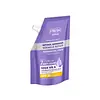What's inside
What's inside
 Key Ingredients
Key Ingredients

 Benefits
Benefits

 Concerns
Concerns

 Ingredients Side-by-side
Ingredients Side-by-side

Water
Skin ConditioningOctocrylene
UV AbsorberGlycerin
HumectantC12-15 Alkyl Benzoate
AntimicrobialMethylene Bis-Benzotriazolyl Tetramethylbutylphenol
UV FilterCaprylic/Capric Triglyceride
MaskingPolysorbate 20
EmulsifyingBis-Ethylhexyloxyphenol Methoxyphenyl Triazine
Skin ConditioningSodium Polyacryloyldimethyl Taurate
Emulsion StabilisingHydrogenated Polydecene
EmollientSqualane
EmollientButylene Glycol
HumectantEuterpe Oleracea Fruit Extract
Bisabolol
MaskingTocopheryl Acetate
AntioxidantHydrolyzed Collagen
EmollientEthylhexylglycerin
Skin ConditioningDecyl Glucoside
CleansingParfum
MaskingXanthan Gum
EmulsifyingCarbomer
Emulsion StabilisingAcrylates/C10-30 Alkyl Acrylate Crosspolymer
Emulsion StabilisingTrideceth-10
CleansingPalmitoyl Tetrapeptide-7
Skin ConditioningPalmitoyl Tripeptide-1
Skin ConditioningDipeptide Diaminobutyroyl Benzylamide Diacetate
Skin ConditioningCeramide NP
Skin ConditioningCeramide AP
Skin ConditioningCeramide EOP
Skin ConditioningChlorphenesin
AntimicrobialRetinol
Skin ConditioningPhytosphingosine
Skin ConditioningSodium Hyaluronate
HumectantCholesterol
EmollientSodium Lauroyl Lactylate
EmulsifyingPhenoxyethanol
PreservativeUbiquinone
AntioxidantHydroxypropyl Cyclodextrin
MaskingWater, Octocrylene, Glycerin, C12-15 Alkyl Benzoate, Methylene Bis-Benzotriazolyl Tetramethylbutylphenol, Caprylic/Capric Triglyceride, Polysorbate 20, Bis-Ethylhexyloxyphenol Methoxyphenyl Triazine, Sodium Polyacryloyldimethyl Taurate, Hydrogenated Polydecene, Squalane, Butylene Glycol, Euterpe Oleracea Fruit Extract, Bisabolol, Tocopheryl Acetate, Hydrolyzed Collagen, Ethylhexylglycerin, Decyl Glucoside, Parfum, Xanthan Gum, Carbomer, Acrylates/C10-30 Alkyl Acrylate Crosspolymer, Trideceth-10, Palmitoyl Tetrapeptide-7, Palmitoyl Tripeptide-1, Dipeptide Diaminobutyroyl Benzylamide Diacetate, Ceramide NP, Ceramide AP, Ceramide EOP, Chlorphenesin, Retinol, Phytosphingosine, Sodium Hyaluronate, Cholesterol, Sodium Lauroyl Lactylate, Phenoxyethanol, Ubiquinone, Hydroxypropyl Cyclodextrin
Water
Skin ConditioningSnail Secretion Filtrate
Skin ConditioningNiacinamide
SmoothingButylene Glycol
HumectantCaprylic/Capric Triglyceride
MaskingCetearyl Olivate
Glycerin
HumectantSorbitan Olivate
EmulsifyingMicrocrystalline Wax
Emulsion StabilisingSodium Polyacrylate
AbsorbentCarbomer
Emulsion StabilisingHydroxyacetophenone
AntioxidantBenzyl Glycol
SolventArginine
MaskingCaprylyl Glycol
EmollientPentylene Glycol
Skin ConditioningGlyceryl Starch
AbsorbentPolyacrylate-2
Sodium Acrylate/Sodium Acryloyldimethyl Taurate Copolymer
Emulsion StabilisingRaspberry Ketone
MaskingIsohexadecane
EmollientDisodium EDTA
Butoxydiglycol
MaskingPolysorbate 80
EmulsifyingSorbitan Oleate
EmulsifyingAdenosine
Skin ConditioningBHT
AntioxidantParfum
MaskingWater, Snail Secretion Filtrate, Niacinamide, Butylene Glycol, Caprylic/Capric Triglyceride, Cetearyl Olivate, Glycerin, Sorbitan Olivate, Microcrystalline Wax, Sodium Polyacrylate, Carbomer, Hydroxyacetophenone, Benzyl Glycol, Arginine, Caprylyl Glycol, Pentylene Glycol, Glyceryl Starch, Polyacrylate-2, Sodium Acrylate/Sodium Acryloyldimethyl Taurate Copolymer, Raspberry Ketone, Isohexadecane, Disodium EDTA, Butoxydiglycol, Polysorbate 80, Sorbitan Oleate, Adenosine, BHT, Parfum
 Reviews
Reviews

Ingredients Explained
These ingredients are found in both products.
Ingredients higher up in an ingredient list are typically present in a larger amount.
Butylene Glycol (or BG) is used within cosmetic products for a few different reasons:
Overall, Butylene Glycol is a safe and well-rounded ingredient that works well with other ingredients.
Though this ingredient works well with most skin types, some people with sensitive skin may experience a reaction such as allergic rashes, closed comedones, or itchiness.
Learn more about Butylene GlycolThis ingredient is an emollient, solvent, and texture enhancer. It is considered a skin-softener by helping the skin prevent moisture loss.
It helps thicken a product's formula and makes it easier to spread by dissolving clumping compounds.
Caprylic Triglyceride is made by combining glycerin with coconut oil, forming a clear liquid.
While there is an assumption Caprylic Triglyceride can clog pores due to it being derived from coconut oil, there is no research supporting this.
Learn more about Caprylic/Capric TriglycerideCarbomer is a polymer of acrylic acid. Its main role is to create a gel consistency.
A high amount of carbomer can cause pilling or balling up of products. Don't worry, most products contain 1% or less of carbomer.
Glycerin is already naturally found in your skin. It helps moisturize and protect your skin.
A study from 2016 found glycerin to be more effective as a humectant than AHAs and hyaluronic acid.
As a humectant, it helps the skin stay hydrated by pulling moisture to your skin. The low molecular weight of glycerin allows it to pull moisture into the deeper layers of your skin.
Hydrated skin improves your skin barrier; Your skin barrier helps protect against irritants and bacteria.
Glycerin has also been found to have antimicrobial and antiviral properties. Due to these properties, glycerin is often used in wound and burn treatments.
In cosmetics, glycerin is usually derived from plants such as soybean or palm. However, it can also be sourced from animals, such as tallow or animal fat.
This ingredient is organic, colorless, odorless, and non-toxic.
Glycerin is the name for this ingredient in American English. British English uses Glycerol/Glycerine.
Learn more about GlycerinParfum is a catch-all term for an ingredient or more that is used to give a scent to products.
Also called "fragrance", this ingredient can be a blend of hundreds of chemicals or plant oils. This means every product with "fragrance" or "parfum" in the ingredients list is a different mixture.
For instance, Habanolide is a proprietary trade name for a specific aroma chemical. When used as a fragrance ingredient in cosmetics, most aroma chemicals fall under the broad labeling category of “FRAGRANCE” or “PARFUM” according to EU and US regulations.
The term 'parfum' or 'fragrance' is not regulated in many countries. In many cases, it is up to the brand to define this term.
For instance, many brands choose to label themselves as "fragrance-free" because they are not using synthetic fragrances. However, their products may still contain ingredients such as essential oils that are considered a fragrance by INCI standards.
One example is Calendula flower extract. Calendula is an essential oil that still imparts a scent or 'fragrance'.
Depending on the blend, the ingredients in the mixture can cause allergies and sensitivities on the skin. Some ingredients that are known EU allergens include linalool and citronellol.
Parfum can also be used to mask or cover an unpleasant scent.
The bottom line is: not all fragrances/parfum/ingredients are created equally. If you are worried about fragrances, we recommend taking a closer look at an ingredient. And of course, we always recommend speaking with a professional.
Learn more about ParfumWater. It's the most common cosmetic ingredient of all. You'll usually see it at the top of ingredient lists, meaning that it makes up the largest part of the product.
So why is it so popular? Water most often acts as a solvent - this means that it helps dissolve other ingredients into the formulation.
You'll also recognize water as that liquid we all need to stay alive. If you see this, drink a glass of water. Stay hydrated!
Learn more about Water